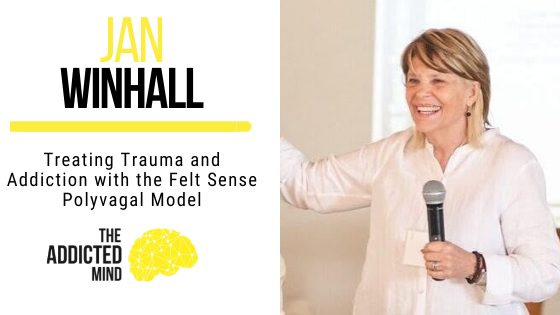On today’s episode, Duane speaks with Jan Winhall, the author of Treating Trauma and Addiction with the Felt Sense Polyvagal Model: A Bottom-Up Approach. Jan’s book is a combination of over 40 years of working with trauma and addiction and reflecting on how to bring an embodied approach to addiction treatment.
We currently understand trauma and addiction from more of a top-down cognitive approach. For example, the DSM, the Diagnostic and Statistical Manual, sees it through a pathologizing lens. When Jan started her work, she was fresh out of graduate school where she got assigned to run a group for young women who were incest survivors. Early on, it taught her how to understand addiction through the nervous system.
As feminist therapists, they were very curious about using new models because they felt the current models were misogynistic. Instead of helping women feel empowered, they did the opposite. They were shocked to see how these women who were viewed as victims of violence were actually being pathologized, getting admitted to hospitals, and being put on medications. This led to the basis of the Polyvagal model which asserted that their responses weren’t maladaptive; rather, their responses were adaptive in maladaptive environments.
Today, Jan explains how our nervous system influences our behavioral choices and how we perceive the world and our situations. She also teaches how we can use the felt sense with the help of others to create a sense of safety in our lives. With that sense of safety, we will be able to choose more strategic behaviors that lead us to become our best selves.
In this episode, you will hear:
- How the dual system of the vagus nerve works
- The Polyvagal model explained
- What happens when the body gets stuck in freeze
- Other blended states in the nervous system
- How to develop felt sensing practices to heal from trauma
- How the state we’re in determines how we experience the world
Key Quotes:
[03:52] – “It was shocking to see how these women that I viewed as being victims of violence were really being pathologized.”
[06:49] – “All of these behavioral addictions and substance abuse stuff were ways that we’re helping them to numb they kind of got that on some level.”
[09:05] – “Our autonomic nervous system is the part of us that watches to see if we’re safe. And if we don’t feel safe enough, then we move into that flight-fight place in the sympathetic branch.”
[09:24] – “The dorsal branch of the vagus nerve simultaneously helps you and kicks in when you’re in a big trouble by shutting everything down in the body.”
[10:42] – “Our bodies have this way of protecting us when we really need to shut down. The problem is that we get stuck there.”
[12:40] – “You can see when someone gets triggered, the traumatic experience becomes as fresh as if it was happening right now.”
[17:32] – “Through the practice of felt sensing, you’re learning slowly, over time, how to feel safe enough in your body to connect with your feelings and let go of dissociating, and numbing, and being more and more and more present with yourself.”
[21:32] – “To take responsibility, you have to be present and you have to be gentle with yourself.”
[24:53] – “How we feel, how we experience the world is determined by what state we’re in.”
Subscribe and Review
Have you subscribed to our podcast? We’d love for you to subscribe if you haven’t yet.
We’d love it even more if you could drop a review or 5-star rating over on Apple Podcasts. Simply select “Ratings and Reviews” and “Write a Review” then a quick line with your favorite part of the episode. It only takes a second and it helps spread the word about the podcast.
If you really enjoyed this episode, we’ve created a PDF that has all of the key information for you from the episode. Just fill in your information below to download it.

